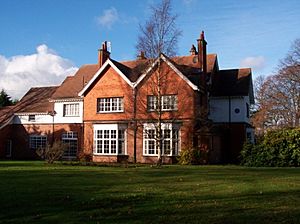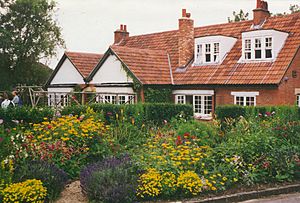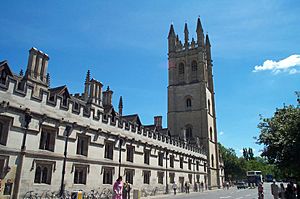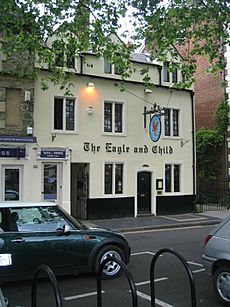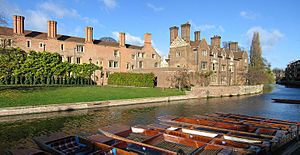C. S. Lewis facts for kids
Quick facts for kids
C. S. Lewis
|
|
|---|---|
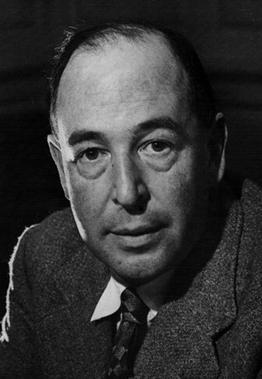
Lewis, age 48
|
|
| Born | Clive Staples Lewis 29 November 1898 Belfast, Ireland |
| Died | 22 November 1963 (aged 64) Oxford, England |
| Pen name | Clive Hamilton, N. W. Clerk |
| Occupation | Novelist, scholar, broadcaster |
| Alma mater | University College, Oxford |
| Genre | Christian apologetics, fantasy, science fiction, children's literature |
| Notable works | The Chronicles of Narnia Mere Christianity The Allegory of Love The Screwtape Letters The Space Trilogy Till We Have Faces Surprised by Joy: The Shape of My Early Life |
| Spouse | |
| Children | 2 step-sons; including Douglas Gresham |
| Relatives | Warren Lewis (brother) |
Clive Staples Lewis (born November 29, 1898 – died November 22, 1963), known to most as C. S. Lewis, was a British scholar and writer. He wrote around 40 books during his life.
Lewis was born in Belfast, Northern Ireland. He is very famous for his fantasy stories, especially for children. He also wrote many essays and books about literature and Christianity.
His books have been translated into more than 30 languages. Lewis was a professor of literature at both the University of Oxford and the University of Cambridge.
He was married to an American writer named Joy Davidman from 1956 until she died in 1960. C. S. Lewis himself passed away in Oxford in 1963.
Many people enjoy his writing, and several of his books have been made into movies. His most well-known fantasy series is The Chronicles of Narnia, which has seven books.
Contents
About C. S. Lewis
His Early Life
Clive Staples Lewis was born in Belfast, Ireland, on November 29, 1898. His father, Albert James Lewis, was a lawyer. His mother, Florence Augusta Lewis, was known as Flora. Lewis had an older brother named Warren Hamilton Lewis, who they called "Warnie."
When Lewis was four years old, his dog Jacksie was hit by a car and died. Lewis was so sad that he started calling himself Jacksie. Later, he accepted the name Jack, which his friends and family used for the rest of his life. When he was seven, his family moved to "Little Lea," their childhood home in East Belfast.
As a boy, Lewis loved stories about animals that acted like humans. He enjoyed Beatrix Potter's books and often wrote and drew his own animal stories. He and his brother Warnie even created their own imaginary world called Boxen, which was run by animals. Lewis loved to read. His father's house was full of books, and Lewis felt it was easy to find a book, "as easy as walking into a field and finding a new blade of grass."
Lewis was taught by private teachers until he was nine. In 1908, his mother died from cancer. After that, he went to different schools during his teenage years. In 1916, Lewis won a scholarship to University College, Oxford.
War and University Life
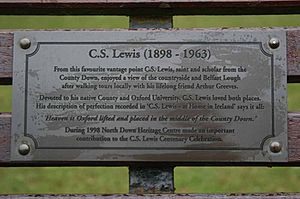
Lewis started at Oxford University in 1917. Soon after, he joined the Officers' Training Corps to become an army officer. Within months, the British Army sent him to France to fight in the First World War.
On his 19th birthday, November 29, 1917, he arrived at the front lines in France. He experienced trench warfare for the first time. On April 15, 1918, Lewis was hurt when a British shell landed too close. Two of his friends were killed.
After Lewis returned to Oxford University, he studied very hard. He earned top grades in Greek, Latin, Philosophy, Ancient History, and English. In 1924, he became a philosophy tutor. In 1925, he became a Fellow and Tutor in English Literature at Magdalen College, Oxford. He worked there for 29 years, until 1954.
Caring for Janie Moore
During his army training, Lewis shared a room with another soldier, Edward Courtnay Francis "Paddy" Moore. Paddy's sister said that Lewis and Paddy made a promise. If one of them died in the war, the other would take care of both their families. Paddy was killed in 1918, and Lewis kept his promise.
Paddy had introduced Lewis to his mother, Janie King Moore. Lewis was 18 and Janie was 45 when they met. They quickly became friends. This friendship was very important to Lewis when he was recovering from his war wounds in the hospital, because his own father did not visit him.
In 1930, Lewis moved into a house called The Kilns with his brother Warnie, Mrs. Moore, and her daughter Maureen. The Kilns was in Oxford. They all helped pay for the house.
Lewis lived with and cared for Mrs. Moore until she became very ill in the late 1940s. She eventually moved into a nursing home, where she died in 1951. Lewis visited her every day until she passed away.
His Return to Faith
Lewis grew up in a religious family. However, he became an atheist when he was 15 years old. He later said he was "very angry with God for not existing" and "equally angry with him for creating a world."
He eventually returned to Christianity. This happened after many discussions with his Oxford friend and fellow Christian, J. R. R. Tolkien.
During the Second World War
When the Second World War started in 1939, the Lewis family took in children who had been sent away from London and other cities for safety. Lewis was 40 years old and tried to join the military again, offering to teach new soldiers. But his offer was not accepted. He later served in the local Home Guard in Oxford, which was a defense group for civilians.
Declining an Honour
In December 1951, King George VI offered Lewis a special honour, to be a Commander of the Order of the British Empire (CBE). However, Lewis politely declined. He did not want to be connected with any political groups or issues.
His Marriage to Joy Davidman
Later in his life, Lewis began writing letters to Joy Davidman Gresham, an American writer. At first, Lewis saw her as a good friend and someone he could talk to about ideas. He agreed to marry her in a civil ceremony so she could continue living in the UK. This civil marriage took place on April 23, 1956.
Soon after, Joy became very ill with bone cancer. Their relationship grew deeper, and they wanted to have a Christian marriage. Because she had been divorced, this was not easy in the Church of England at that time. But a friend, Rev. Peter Bide, performed the ceremony at her hospital bedside on March 21, 1957.
Joy's cancer surprisingly got better for a while, and the couple lived together until 1960. Her cancer returned, and she died on July 13. Lewis continued to raise Joy's two sons after her death.
Illness and Death
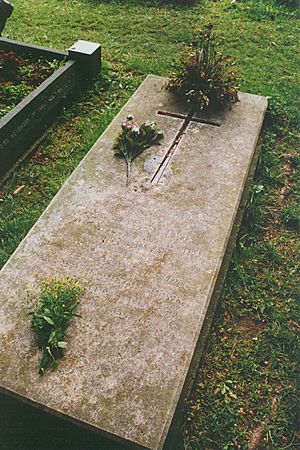
On July 15, 1963, Lewis became very ill and was taken to the hospital. The next day, he had a heart attack and fell into a coma. Surprisingly, he woke up the next day. After leaving the hospital, Lewis returned home, but he was too sick to work. He resigned from his job at Cambridge in August.
Lewis's health continued to get worse. In mid-November, doctors said his kidneys were failing. He collapsed in his bedroom on November 22, just one week before his 65th birthday, and died a few minutes later. He is buried in the churchyard of Holy Trinity Church in Oxford. His brother Warren was buried in the same grave in 1973.
News of Lewis's death was mostly overshadowed by the assassination of US President John F. Kennedy, which happened on the same day. Another famous writer, Aldous Huxley, also died that day.
His Work and Books
As a Scholar
Lewis began his academic career as a student at Oxford University. He earned the highest honours in three different subjects. He then became a Fellow at Magdalen College, Oxford, where he taught for almost 30 years, from 1925 to 1954.
Lewis wrote many books and articles. He had a group of literary friends who met regularly to discuss their writings. This group was called the "Inklings." Famous members included J. R. R. Tolkien, who wrote The Lord of the Rings, and Lewis's brother, Warren.
As a Novelist
Besides his scholarly work, Lewis wrote several popular novels. These include the science fiction Space Trilogy for adults and the Narnia fantasies for children. Most of his stories subtly explore Christian ideas like sin, humanity's fall from grace, and redemption.
His first novel after becoming a Christian was The Pilgrim's Regress (1933). It showed his journey to Christianity, similar to the style of John Bunyan's The Pilgrim's Progress. He then wrote the Space Trilogy.
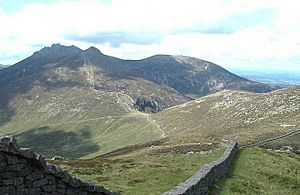
The Chronicles of Narnia is a series of seven fantasy novels for children. It is considered a classic of children's literature. Lewis wrote these books between 1949 and 1954. The series is his most popular work, selling over 100 million copies in 41 languages. It has been made into radio shows, TV shows, plays, and movies several times.
The books contain Christian ideas that are easy for young readers to understand. Besides Christian themes, Lewis also used characters from Greek and Roman mythology, as well as traditional British and Irish fairy tales.
His Legacy
In 2013, 50 years after his death, Lewis was honored at Poets' Corner in Westminster Abbey. This is a special place where many of Britain's greatest writers are recognized.
Many books have been written about Lewis's life. Some were written by his close friends. In 1985, a TV movie called Shadowlands told the story of Lewis's life and his relationship with Joy Davidman Gresham. It was later made into a play and a 1993 movie.
A bronze statue of Digory, a character from Lewis's book The Magician's Nephew, stands in Belfast. It is in front of the Holywood Road Library.
There are several C. S. Lewis Societies around the world. One was started in Oxford in 1982.
Three of The Chronicles of Narnia books have been made into live-action movies: The Lion, the Witch, and the Wardrobe (2005), Prince Caspian (2008), and The Voyage of the Dawn Treader (2010).
Lewis is also a main character in The Chronicles of the Imaginarium Geographica book series by James A. Owen. He is one of two characters in a 2009 play called Freud's Last Session. This play imagines a meeting between Lewis and Sigmund Freud in London in 1939, just before World War II began.
The CS Lewis Nature Reserve is on land that Lewis owned, behind his house, The Kilns. People can visit this nature reserve.
Images for kids
See also
 In Spanish: C. S. Lewis para niños
In Spanish: C. S. Lewis para niños


